Test proposed value using the principles of lean startup and customer development
In your last post I described a new business tool – the Outline of the proposed values. In this post I will explain how you can use this tool not only for value proposition development, but also to test it. You will learn how to apply effective principles of lean startup and customer development in designing, testing and building what you really want to obtain consumers.
Outline the proposed values allows to consider in detail the value of your offer and needs of your target segments. To improve the value proposition in its development, you can use poster (see image below) and stickers. At the same time, to make sure that consumers really need what you are developing, you should test all the assumptions that you put forward on the Outline of the proposed values.
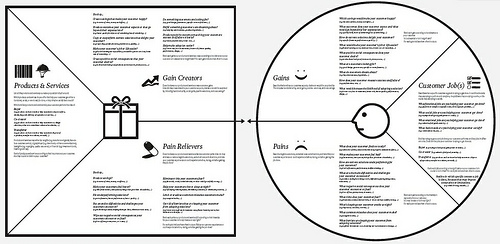
We already know how to design and test business models using a combination of Canvas business model and the development process of the client. Steve Blank demonstrated that their work.
We can do the same with the proposed value by combining the Outline of the proposed values and of the process of lean startup. This will provide a more systematic approach to achieving that in the context of a movement of startups called the product market or line of the solution to the problem – in other words-build/offer what consumers really want.
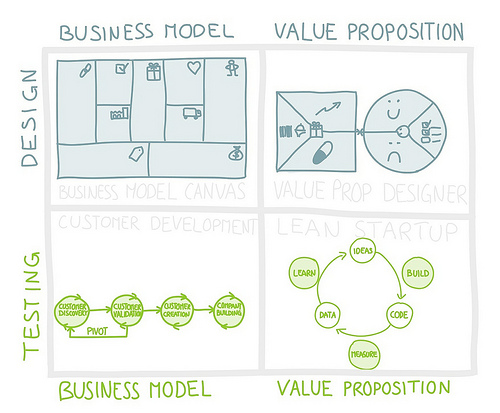
In a nutshell, the process of lean startup is actually a cycle consisting of "build" prototype products (and services), "measurement" and "information gathering" with them. The lean startups movement calls these prototypes minimum viable products (MVP).
Outline the proposed values can add to this process is now missing two key aspects that will lead us to a whole new level.
First, the Outline of the proposed value provides a simple and practical way to quickly describe WHAT you create, and what, in your opinion, it will be valuable to consumers, as well as WHY you are creating: what are some of the problems, the pluses and minuses for consumers, you are going to work.
By doing this BEFORE building an MVP, you will be able to better track the process of testing, measuring, and gathering information and to manage it.
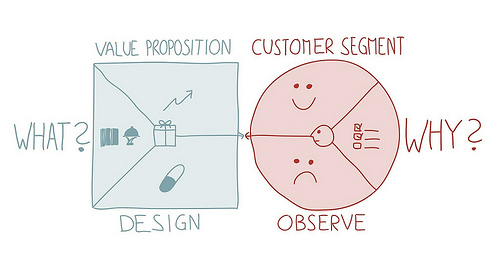
Second, Outline the proposed values helps you to share the concept of assumptions about the product/offer values and assumptions about the consumer. If you "just" build an MVP to measure and collect information, you will not know whether the negative results of your experiment with your MVP or with lack of interest from consumers.
In science, this is a significant omission would make the results not valid. So you need to split test their assumptions about the product/offer value (i.e., WHAT) and their assumptions about the consumer (i.e. WHY) wherever possible. The latter can detect and investigate even before designing MVP.
Let me take you through a rough step-by-step process of using the Canvas offer value in testing. In reality, of course, these steps will be less consistent and more erratic. You also want to adapt this process to their needs and conditions.
Describe the TASKS trying to fulfill the consumer with your product and indicate the ADVANTAGES and DISADVANTAGES for your client. List the PRODUCTS and SERVICES you intend to offer and describe how, in your opinion, they will SOFTEN the DOWNSIDES for your consumer and CREATE ADVANTAGES. If you need help, you can use leading questions in the poster my last post blog.
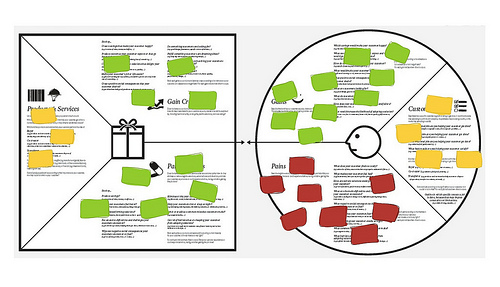
Voila, now you have a great list of assumptions about the product/offer value and consumer. You describe what, in your opinion, are consumers, and what, in your opinion, will create value for them. It's your best guess, which so far represents only your (reasonable) opinion.

Now, in the words of Steve blank, it's time to "leave the office" to check assumptions about their consumers. Talk with the greatest possible number of potential customers to check whether they are trying to accomplish the TASKS you described on the Outline of the proposed values. Find out whether these TASKS are critically important or insignificant? Find out whether they are experiencing those DISADVANTAGES, which, in your opinion, they must experience. Whether these DISADVANTAGES are strong or weak? Verify whether they appreciate the ADVANTAGES that, in your opinion, they should appreciate.
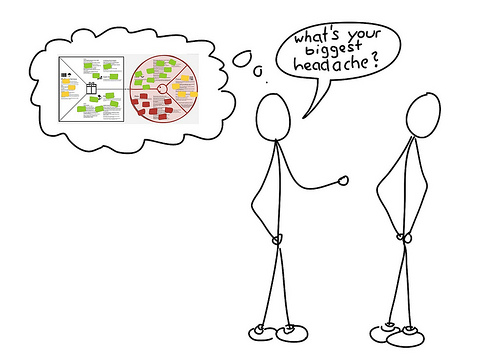
The more you will be able to test assumptions about the consumer, the better. I mean, not only talking with consumers, but not yet necessary to build the MVP. Professional designers also use several methods.
Now that you better know its customers, it is necessary to refer to the portrait of the consumer on the Outline of the proposed values. Ideally, now you understand the importance of the TASKS of its consumers, the power of the PROS and CONS of your product as well as their DESIRES.

Based on the received consumer information, select the advantages and disadvantages, which you want to focus. Next, adjust your proposed value. Don't forget that we offer good value is rarely directed to the relief of all the DOWNSIDES to the consumer and giving him all the ADVANTAGES. She pays really great attention to only a few of them!

So you get a fixed Outline of the proposed values.

Now it's time to build your MVP and continuously test and change the proposed value on the basis of the information collected.

Outline the proposed values will serve as a map for the ongoing monitoring of assumptions and tests during the advancement of the process of lean startup. This cycle will end in the moment when you reach the fit between your proposed value and expectations of consumers. Is that within the movement of lean startups is called the product market or line of the solution to the problem – when you do what you really want to consumers!
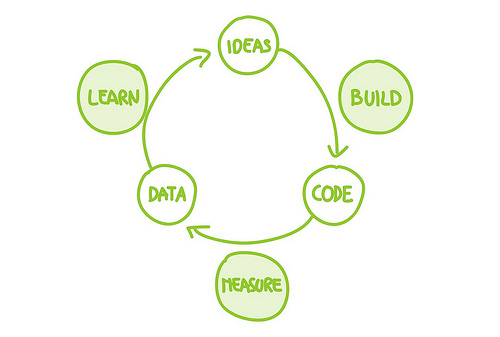
Feel free to leave your feedback, since this process is only the first recommendation on how to use the Outline of the proposed values.
the Translation is done in the framework of the summer school startups Tolstoy Summer Camp.
Article based on information from habrahabr.ru
Outline the proposed values allows to consider in detail the value of your offer and needs of your target segments. To improve the value proposition in its development, you can use poster (see image below) and stickers. At the same time, to make sure that consumers really need what you are developing, you should test all the assumptions that you put forward on the Outline of the proposed values.

We already know how to design and test business models using a combination of Canvas business model and the development process of the client. Steve Blank demonstrated that their work.
We can do the same with the proposed value by combining the Outline of the proposed values and of the process of lean startup. This will provide a more systematic approach to achieving that in the context of a movement of startups called the product market or line of the solution to the problem – in other words-build/offer what consumers really want.

In a nutshell, the process of lean startup is actually a cycle consisting of "build" prototype products (and services), "measurement" and "information gathering" with them. The lean startups movement calls these prototypes minimum viable products (MVP).
using the lean startup process
Outline the proposed values can add to this process is now missing two key aspects that will lead us to a whole new level.
First, the Outline of the proposed value provides a simple and practical way to quickly describe WHAT you create, and what, in your opinion, it will be valuable to consumers, as well as WHY you are creating: what are some of the problems, the pluses and minuses for consumers, you are going to work.
By doing this BEFORE building an MVP, you will be able to better track the process of testing, measuring, and gathering information and to manage it.

Second, Outline the proposed values helps you to share the concept of assumptions about the product/offer values and assumptions about the consumer. If you "just" build an MVP to measure and collect information, you will not know whether the negative results of your experiment with your MVP or with lack of interest from consumers.
In science, this is a significant omission would make the results not valid. So you need to split test their assumptions about the product/offer value (i.e., WHAT) and their assumptions about the consumer (i.e. WHY) wherever possible. The latter can detect and investigate even before designing MVP.
step-by-Step using the Outline of the proposed values
Let me take you through a rough step-by-step process of using the Canvas offer value in testing. In reality, of course, these steps will be less consistent and more erratic. You also want to adapt this process to their needs and conditions.
1. Fill in the Outline of the proposed value.
Describe the TASKS trying to fulfill the consumer with your product and indicate the ADVANTAGES and DISADVANTAGES for your client. List the PRODUCTS and SERVICES you intend to offer and describe how, in your opinion, they will SOFTEN the DOWNSIDES for your consumer and CREATE ADVANTAGES. If you need help, you can use leading questions in the poster my last post blog.

Voila, now you have a great list of assumptions about the product/offer value and consumer. You describe what, in your opinion, are consumers, and what, in your opinion, will create value for them. It's your best guess, which so far represents only your (reasonable) opinion.

2. Test assumptions about the consumer.
Now, in the words of Steve blank, it's time to "leave the office" to check assumptions about their consumers. Talk with the greatest possible number of potential customers to check whether they are trying to accomplish the TASKS you described on the Outline of the proposed values. Find out whether these TASKS are critically important or insignificant? Find out whether they are experiencing those DISADVANTAGES, which, in your opinion, they must experience. Whether these DISADVANTAGES are strong or weak? Verify whether they appreciate the ADVANTAGES that, in your opinion, they should appreciate.

The more you will be able to test assumptions about the consumer, the better. I mean, not only talking with consumers, but not yet necessary to build the MVP. Professional designers also use several methods.
3. Correct their assumptions about the user based on the received information from him.
Now that you better know its customers, it is necessary to refer to the portrait of the consumer on the Outline of the proposed values. Ideally, now you understand the importance of the TASKS of its consumers, the power of the PROS and CONS of your product as well as their DESIRES.

4. Change the proposed value on the basis of the information received.
Based on the received consumer information, select the advantages and disadvantages, which you want to focus. Next, adjust your proposed value. Don't forget that we offer good value is rarely directed to the relief of all the DOWNSIDES to the consumer and giving him all the ADVANTAGES. She pays really great attention to only a few of them!

So you get a fixed Outline of the proposed values.

5. Start testing the proposed values.
Now it's time to build your MVP and continuously test and change the proposed value on the basis of the information collected.

Outline the proposed values will serve as a map for the ongoing monitoring of assumptions and tests during the advancement of the process of lean startup. This cycle will end in the moment when you reach the fit between your proposed value and expectations of consumers. Is that within the movement of lean startups is called the product market or line of the solution to the problem – when you do what you really want to consumers!

Feel free to leave your feedback, since this process is only the first recommendation on how to use the Outline of the proposed values.
the Translation is done in the framework of the summer school startups Tolstoy Summer Camp.
Comments
Post a Comment